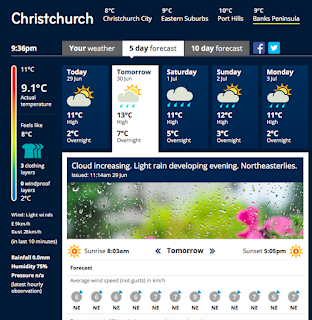Later, we piled into the Gator Waka and drove to Lyttelton Harbour, where we stopped at Governor's Bay to explore nearby tidal pools and shoreline. There, we saw spoonbills, kingfisher, and silver eyes, as well as a lone homing pigeon and a bell bird, which was heard but not seen.
Then we backtracked a bit and stopped at She Restaurant & Cafe, which marketed the best chocolate in all of New Zealand. At the cafe, some enjoyed rich hot chocolates and superfood smoothies, while others sampled chocolate truffles and flavourful chai lattes.
Finally, we drove back to Lincoln, since the stores around the harbour close early.
Meryl showing us the sections of the flax plant that should never be harvested since it would kill the entire plant.
Dr. Hostetler exposing the orange sori of the Hound's Tongue Fern.
The view from the Port Hills. Note the hogsback, the cloud formation at the top of the picture that resembles a slightly arched back and is formed when a norwester blows from the west. Also note that the land is entirely agricultural from the mountains to the coast.
Another stunning view from the rocks on the Port Hills.
At the tip of the rock, you can just barely see a slight pointed instrument sticking up from the ground. This contraption monitors and records both weather and earthquakes.
Tatiana, seen enjoying her lunch spot at the top of the rock. She later abandoned the position as the wind picked up.
Group photo at the top of our Port Hills hike.
The Crater Rim Walkaway trail along the Port Hills.
Governor's Bay, where we stopped and explored for a bit.
Erika holding one of the many tiny crabs found under overturned rocks near Governor's Bay.
The group, seen exploring tidal pools and searching for sea stars.
Marta and Savannah showing off the physical evidence of a successful hunt for starfish.
In the background, the harbour opens to the Pacific and provides passage for barges and shipping containers, which introduce invasive exotic species when they lighten their loads by dumping foreign waters from the hull of the ship into the harbour waters.
The outside deck of the She Restaurant & Cafe, where we stopped for libations.
– Anna


















